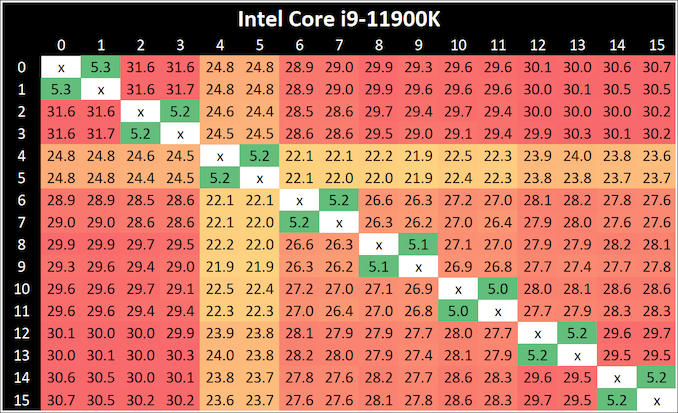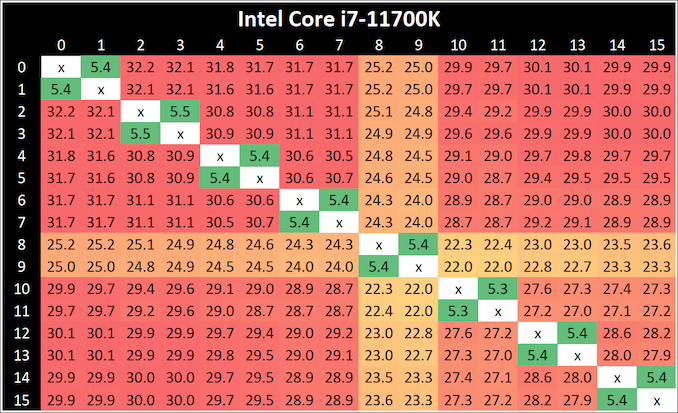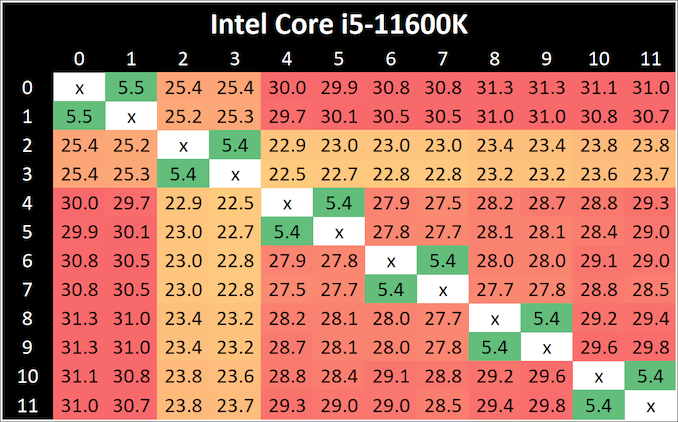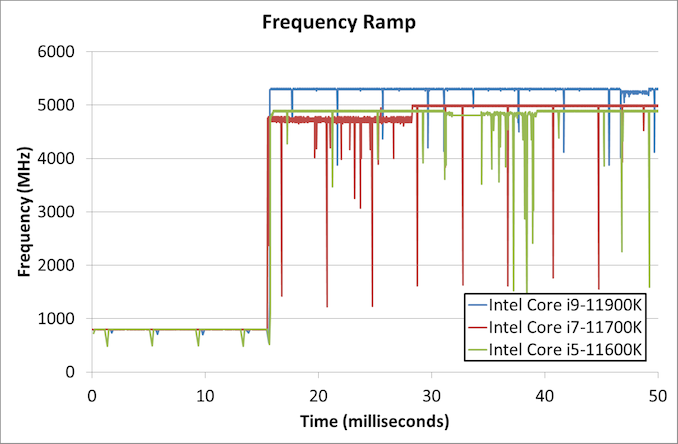Intel Rocket Lake (14nm) Review: Core i9-11900K, Core i7-11700K, and Core i5-11600K
by Dr. Ian Cutress on March 30, 2021 10:03 AM EST- Posted in
- CPUs
- Intel
- LGA1200
- 11th Gen
- Rocket Lake
- Z590
- B560
- Core i9-11900K
CPU Tests: Microbenchmarks
Core-to-Core Latency
As the core count of modern CPUs is growing, we are reaching a time when the time to access each core from a different core is no longer a constant. Even before the advent of heterogeneous SoC designs, processors built on large rings or meshes can have different latencies to access the nearest core compared to the furthest core. This rings true especially in multi-socket server environments.
But modern CPUs, even desktop and consumer CPUs, can have variable access latency to get to another core. For example, in the first generation Threadripper CPUs, we had four chips on the package, each with 8 threads, and each with a different core-to-core latency depending on if it was on-die or off-die. This gets more complex with products like Lakefield, which has two different communication buses depending on which core is talking to which.
If you are a regular reader of AnandTech’s CPU reviews, you will recognize our Core-to-Core latency test. It’s a great way to show exactly how groups of cores are laid out on the silicon. This is a custom in-house test built by Andrei, and we know there are competing tests out there, but we feel ours is the most accurate to how quick an access between two cores can happen.
All three CPUs exhibit the same behaviour - one core seems to be given high priority, while the rest are not.
Frequency Ramping
Both AMD and Intel over the past few years have introduced features to their processors that speed up the time from when a CPU moves from idle into a high powered state. The effect of this means that users can get peak performance quicker, but the biggest knock-on effect for this is with battery life in mobile devices, especially if a system can turbo up quick and turbo down quick, ensuring that it stays in the lowest and most efficient power state for as long as possible.
Intel’s technology is called SpeedShift, although SpeedShift was not enabled until Skylake.
One of the issues though with this technology is that sometimes the adjustments in frequency can be so fast, software cannot detect them. If the frequency is changing on the order of microseconds, but your software is only probing frequency in milliseconds (or seconds), then quick changes will be missed. Not only that, as an observer probing the frequency, you could be affecting the actual turbo performance. When the CPU is changing frequency, it essentially has to pause all compute while it aligns the frequency rate of the whole core.
We wrote an extensive review analysis piece on this, called ‘Reaching for Turbo: Aligning Perception with AMD’s Frequency Metrics’, due to an issue where users were not observing the peak turbo speeds for AMD’s processors.
We got around the issue by making the frequency probing the workload causing the turbo. The software is able to detect frequency adjustments on a microsecond scale, so we can see how well a system can get to those boost frequencies. Our Frequency Ramp tool has already been in use in a number of reviews.
From an idle frequency of 800 MHz, It takes ~16 ms for Intel to boost to the top frequency for both the i9 and the i5. The i7 was most of the way there, but took an addition 10 ms or so.














279 Comments
View All Comments
Hulk - Tuesday, March 30, 2021 - link
I have also been looking for iGPU tests?It's strange. It's like it doesn't exist.
eastcoast_pete - Tuesday, March 30, 2021 - link
Predictable results. I don't believe Intel back-ported to 14 nm because their 10 nm couldn't reach high frequencies, they back-ported because their yields at 10 nm aren't high enough and they had manufacturing capacity available at 14 nm. That made the expense of back-porting the design worthwhile.Regarding Rocket Lake, the most interesting CPUs in this lineup are the non-K i5, especially the ones that still have the 32 EUs enabled. Any chance you (Ian) can put one or two 11500 or 11600 through their paces. I would really like to also see how "35 W" the T models are. One of those, plus a decent, WiFi-enabled 560 MoBo for $100-130 could serve HTPC and office duties.
Otritus - Tuesday, March 30, 2021 - link
Rocket lake is an 8 core cpu based on the cypress (sunny) cove microarchitecture. Tigerlake H is an 8 core cpu based on the willow (sunny+) cove microarchitecture. Both have 32 Xe EUs. 10SF and 10ESF yields well (Intel is shipping much larger server processors just fine). The problem is 10SF seems to max out around 5Ghz which is the upper bounds of the 11700K. The slight clock bump of the 11900K lets Intel claim the fastest gaming cpu, which would not have been possible on Tigerlake H. 14nm having excess capacity was simply the cherry on top.goatfajitas - Tuesday, March 30, 2021 - link
I dont th9ink anything Intel has done here can be called "cherry on top" if anything we will look on this as a hot mess (pun intended). :PAntonErtl - Wednesday, March 31, 2021 - link
Intel shipping larger chips in their current 10nm processes does not disprove yield problems. If there is a flaw in a core on a 40-core die, jut disable the core (and another one) and sell it as 38-core CPU. If there are flaws in three cores, sell it as 36-core CPU, etc. Of course that's also possible and done for Tiger Lake, but there is also parts of the CPU where you have no such redundancy, but the area for these parts is not necessarily larger for the bigger dies, and the huge price for the big dies may make it economically more viable there than on the desktop.What makes me believe that either 10nm yield or 10nm capacity is not so great (or capcity is not reat because yield is not great) is that the announced Xeon W-13xx CPUs are going to be Rocket, not Tiger Lake; at 80W TDP, I expect that Tiger Lake would outperform Rocket Lake for most multi-threaded and (thangs to larger cache) some single-threaded workloads, yet they give us Rocket Lake,
Spunjji - Friday, April 9, 2021 - link
Intel arriving nearly 3 years late with Ice Lake SP and only managing "over 200,000" in the first 3 months isn't "just fine", it's pretty indicative that they're still struggling.We have no indication of ESF yields yet as there are no ESF products shipping yet.
Rocket Lake was ported when Intel couldn't get clock speeds *or* yields out of their 10nm process. If their yields and capacity for 10SF were as good as you're implying, we wouldn't still be waiting for Tiger Lake H to actually hit the market so long after Tiger Lake launched.
YazX_ - Tuesday, March 30, 2021 - link
4 years ago, AMD was broke, fighting for survival, targeting the poor and intel was the top dog and spit the same s.hit for the 10 years, fast forward now, AMD is the top dog and intel cannot even catch up.Regarding the review, yah as usual s.hit intel CPU that draws alot of power and still priced higher than AMD while offering less.
haukionkannel - Tuesday, March 30, 2021 - link
And Intel will be selling these much, much more than amd can their own...Intel just need to exist, to win amd in market share...
Qasar - Tuesday, March 30, 2021 - link
haukionkannel yep, only because its on the shelf, if/when ryzen 5000 supply gets better expect that to change. once that happens intel wont be selling that well. no one i know is even looking at intel right now, all waiting for zen 3.SkyBill40 - Tuesday, March 30, 2021 - link
You mean Zen 4?